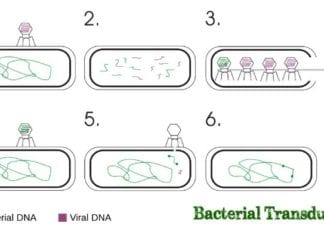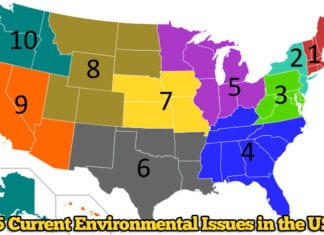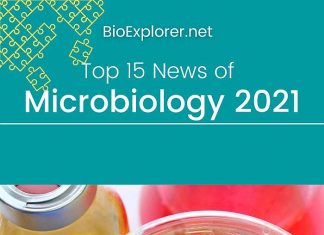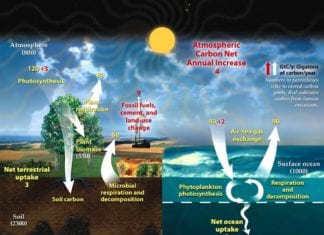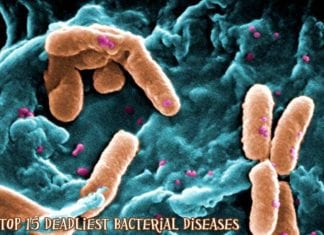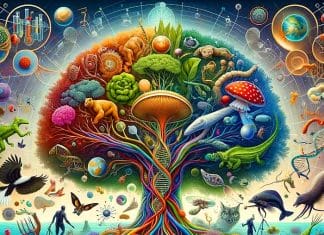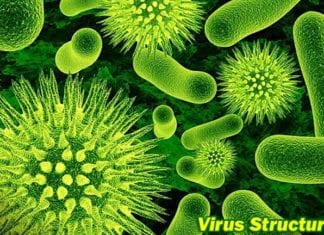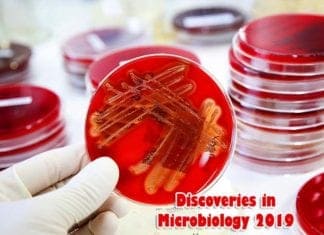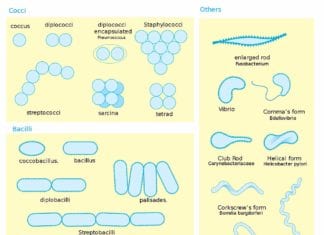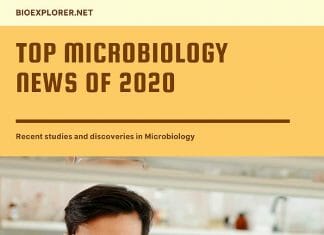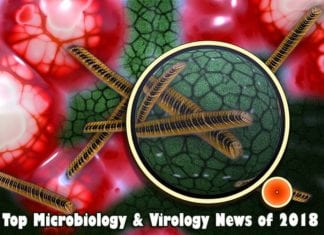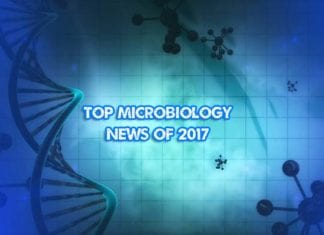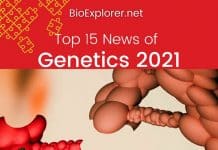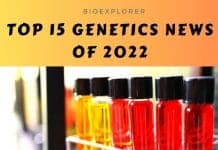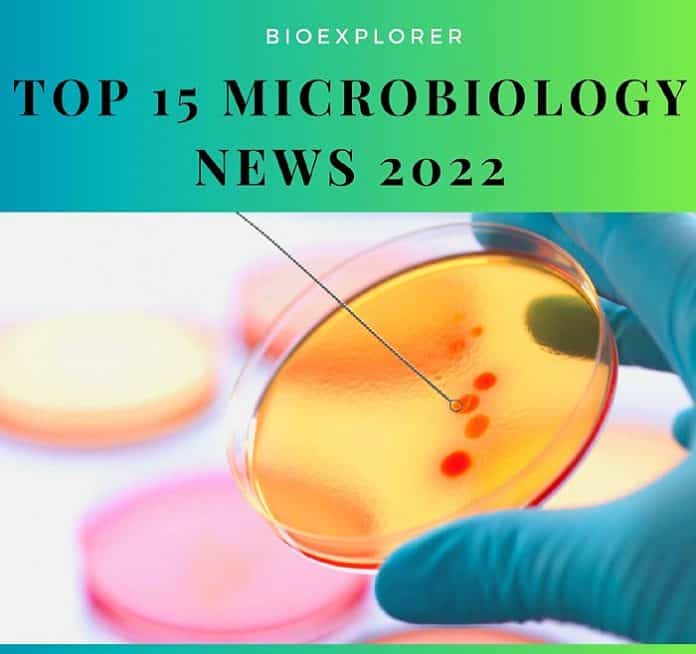
Microbiology News of 2022: The journey through the news of 2022 was mind-boggling, with root colonizing forms to enhance crop production, phage remediation, and therapeutic purpose.
The current knowledge provides new insight into producing renewable energy from microbes, the role played by various microbes in inflammatory diseases, the production of antibiotics, and other therapeutic applications.
Table of Contents
- Top 15 Microbiology News of 2022
- 1. A recent study shows that dried Salmonella on food production equipment can be killed by oil formulations containing food-grade organic acids (USA, Aug 2022)
- 2. Scientists use bacteria to convert methane into electricity (Netherlands, April 2022)
- 3. A recent student-led study suggests that plastic waste in the ocean could be a source of new antibiotics (USA, June 2022)
- 4. Scientists use modified bacterial strains to reduce waterway pollution and fertilize crops (USA, Feb 2022)
- 25 Mind-Blowing Biology Breakthroughs That Shaped Our World!
- 5. A crucial mechanism that builds drug tolerance in microbial communities has been identified through research (UK, Mar 2022)
- 6. Researchers found that microbial diversity has declined as a result of climate warming (USA, June 2022)
- Carbon Cycle Steps: Overview & Importance in Biosphere
- 7. Drug-resistant bacteria have been found to display their strength through detectable morphological changes (Japan, Mar 2022)
- Top 14 Most Infectious and Deadliest Diseases Caused By Bacteria
- 8. Study shows that Influenza A infection may prevent SARS-CoV-2 replication (USA, July 2022)
- 25 Reasons That Emphasizes The Importance of Biology
- 9. Scientists say that as the battle in western Ukraine progresses, the probability of a polio breakout increases (USA, June 2022)
- 10. According to a recent study, probiotics along with prescription antibiotics may lessen harm to the gut microbiome (UK, Nov 2022)
- 11. A study reveals intricate connections between bacteria, lower airway infection, inflammation indicators, and cystic fibrosis (USA, Mar 2022)
- 12. Metabolic activity can be predicted by the genomic structure of microbial communities (USA, Jan 2022)
- 13. A new tool for biotechnology and medicine is created by researchers in the form of a chip that can detect microbial dark matter in soil, water, and the air (Germany, Nov 2022)
- 14. Scientists discovered that Type-1 diabetes has microbial roots (USA, Oct 2022)
- Top 15 Latest Microbiology & Virology Discoveries in 2018
- 15. Researchers believe that triple therapy reduced the risk of death in patients with severe COVID-19 who were hospitalized (USA, Aug 2022)
Top 15 Microbiology News of 2022
Let’s glimpse the 2022 microbiology research outcomes from broader perspectives.
1. A recent study shows that dried Salmonella on food production equipment can be killed by oil formulations containing food-grade organic acids (USA, Aug 2022)
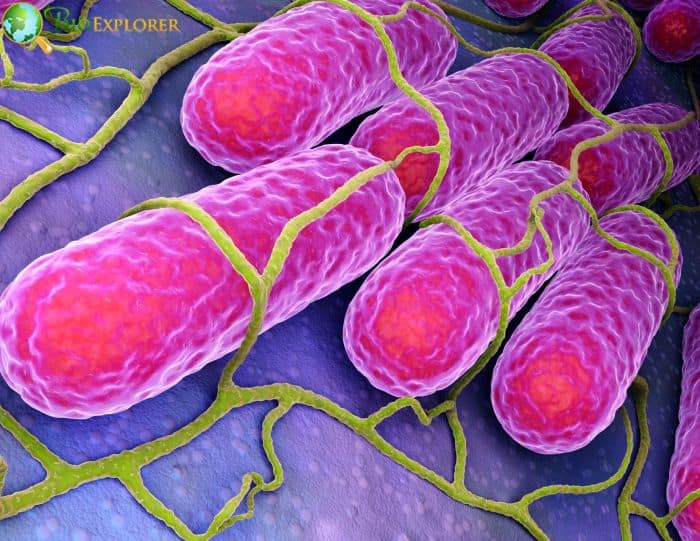
Cleansing manufacturing sites is crucial for a safe food supply. Peanut butter and chocolate have been linked to recent outbreaks of Salmonella in food. Even though Salmonella cannot grow in these low-water foodstuffs, the cells survive and develop increased heat resistance, which has aided in recent outbreaks.
- Salmonella was dried in the investigation on stainless steel surfaces with a regulated relative humidity. Then, they used several oils and organic acids to cover the dried bacteria, adjusting the acid type, concentration, contact duration, and treatment temperature to find highly antibacterial formulations.
- The killing was substantially larger than anticipated when mixing peanut oil and acetic acid at a dosage roughly half that of home vinegar, showing a synergistic effect.
- The results suggest that acidified oils could be employed as an efficient sanitation method in low-moisture food processing plants, where water-based cleaning might be difficult.
- An innovative method of administering antimicrobial substances against food-borne infections involves using oils as a carrier for organic acids.
So, the study may result in applying oil-based methods for industrial cleaning, such as equipment used to make peanut butter and chocolate. It would make it possible to clean these products more frequently, increasing their safety.
Suggested Reading:
Bacterial Transduction: A Mode of Genetic Recombination
2. Scientists use bacteria to convert methane into electricity (Netherlands, April 2022)
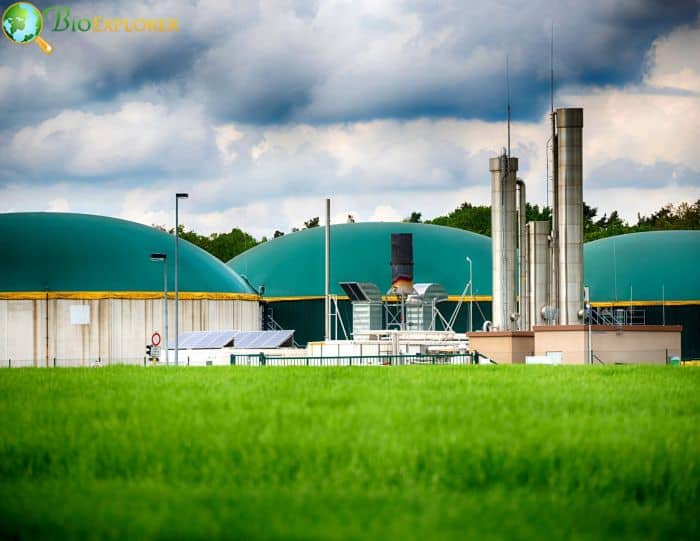
Using microbes to generate power should be possible while clearing the atmosphere of greenhouse gases. Researchers in microbiology have shown that it is possible to use methane-eating bacteria to produce energy in a laboratory setting.
- At first, the researchers were interested in learning more about the conversion processes taking place within the microbe.
- Methane is created by microorganisms in the present biogas systems, which are then burned to power a turbine and produce electricity.
- This method converts less than fifty percent of the biogas into electricity, the maximum capacity till now. We wanted to assess whether employing microbes would improve our performance.
- Nijmegen microbiologists have previously demonstrated that anammox bacteria, which utilize ammonium rather than methane, may be used to produce electricity.
- These bacteria all go through much the same mechanism. One terminal is a biological terminal, and the other is a chemical terminal. Together they form a type of battery.
- On one of the electrodes, where the bacteria are cultivated, the bacteria provide electrons generated by the conversion of methane.
- Using this method, the researchers could turn 31% of the methane into power.
The energy industry might find this to be quite helpful. More research and development are needed further to improve the system.
Suggested Reading:
Top 20 Biomass Energy Pros and Cons
3. A recent student-led study suggests that plastic waste in the ocean could be a source of new antibiotics (USA, June 2022)

Since plastic waste has a high biomass content, it might make an excellent source of antibiotics. Based on a student-led study in association with the Scripps Institute of Oceanography, new antibiotics may be present in plastic pollution in the ocean.
- The researchers adapted the Tiny Earth scientific research approach to marine environments to investigate the possibility that the plastisphere could serve as a source of new antibiotics.
- In the water near Scripps Pier in La Jolla, California, the scientists cultured high and low-density polyethylene plastic (typically seen in supermarket bags) for 90 days.
- Bacillus, Phaeobacter, and Vibrio species were among the 5 antibiotic-producing bacteria the researchers recovered from ocean plastic.
- The isolates were effective against 2 strains of bacteria resistant to antibiotics and various Gram-positive and negative targets.
Finding alternate sources of new antibiotics is crucial, given the present antibiotic shortage and the advent of superbugs. The project is hoped to be further expanded to understand better the bacteria and the antibiotics they might produce.
Suggested Reading:
Top 15 Current Environmental Issues in the US
4. Scientists use modified bacterial strains to reduce waterway pollution and fertilize crops (USA, Feb 2022)

Azotobacter vinelandii, a common soil bacterium that fixes nitrogen, has been modified by scientists to create ammonia and excrete it in high concentrations. It is then transferred to crop plants instead of traditional chemical fertilizers.
- Scientists investigated to understand better nitrogen fixation-the chemical mechanisms by which atmospheric nitrogen is incorporated into organic substances as part of the nitrogen cycle.
- The research was conducted to minimize the serious issues with water pollution caused by excessive nitrogen fertilizer runoff into streams.
- This results in algal blooms that kill fish and other aquatic life and deplete oxygen levels, resulting in “dead zones” in lakes, rivers, and vast ocean stretches.
- The researchers engineered A. vinelandii to create ammonia at a constant rate regardless of the surroundings of the bacteria and to excrete it at quantities high enough to efficiently fertilize crops.
- Gene editing techniques were used instead of adding transgenes into the A. vinelandii genome, which allowed for avoiding regulatory restrictions that would have slowed down complicated and cost-prohibitive development.
Effective broad use of these biofertilizers for farming will decrease pollution, provide healthy ways of handling the nitrogen cycle in soil, lower production costs and raise profit margins for farmers and promote sustainable food production by improving the fertility in the soil.
Suggested Reading:
25 Mind-Blowing Biology Breakthroughs That Shaped Our World!
5. A crucial mechanism that builds drug tolerance in microbial communities has been identified through research (UK, Mar 2022)
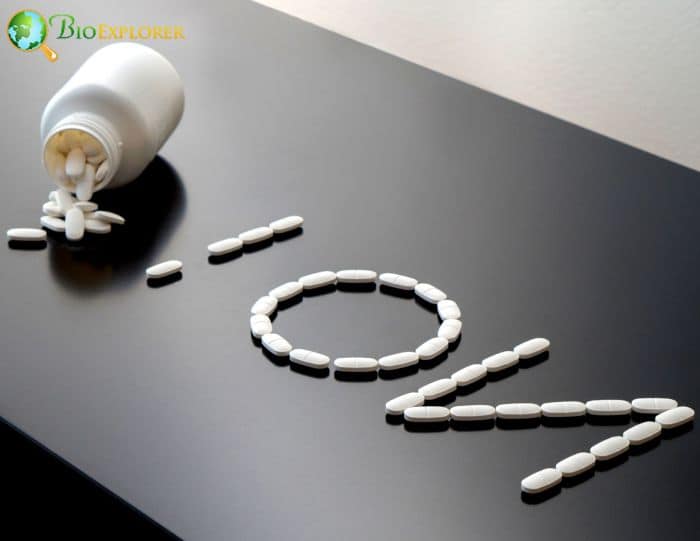
When bacteria, viruses, fungi, or parasites stop responding to treatments, there is a condition known as antimicrobial medication resistance and tolerance. Only three kinds of antifungal medications are now in clinical use, and these antifungals frequently fail. A crucial mechanism that builds drug tolerance in microbial communities has been identified through research.
- Data from 12, 000 microbial populations from around the globe were analyzed by scientists thanks to the Earth Microbiome Project.
- The researchers discovered that one particular bacterium was very common among these communities of other bacteria, which cohabitate, produce, and absorb the materials required to survive and flourish.
- They analyzed 99.95% of the 12, 538 communities had auxotrophs, which cannot produce critical metabolites like amino acids, vitamins, or fatty acids.
- The researchers discovered that colonies with auxotrophs are more likely than communities without these cells to show tolerance to hundreds of medicines.
- Furthermore, the study demonstrated that these cells are not scavengers but cooperative partners because they take up metabolites necessary for them in exchange for returning other metabolites to the community.
- Further research employing a yeast model revealed that this higher tolerance is caused by cells’ greater metabolic export when they collaborate during metabolism. As a result, this also causes medications to be transported out of cells at a greater pace.
This study’s results open up a new area of inquiry: how metabolism and metabolic environment affect antibiotic resistance. This will make it possible to create new antifungal generations that target both cell growth and tolerance, making them more potent than the treatments that are currently available.
Suggested Reading:
Top 15 Microbiology News of 2021
6. Researchers found that microbial diversity has declined as a result of climate warming (USA, June 2022)

According to research, the microbial variety necessary for healthy soil is being reduced due to global warming. From a local to a global level, climate change is a key cause of biodiversity loss, which may further affect ecosystem services and functioning.
- Researchers used a long-term multifactor field experiment site to examine how the biodiversity of bacteria, fungi, and protozoa in grassland soil has changed since 2009.
- They examined how soil microbial communities have reacted to experimental warming, altered precipitation, and clipping (annual biomass removal).
- The results provide direct proof that, in a field environment, long-term climate warming decreases microbial biodiversity.
- Also, this is the first study to show how differently spore- and non-spore-forming microorganisms respond to climate change and how warming primarily controls microbial biodiversity.
- Since the primary effect of climate change on biodiversity is reduced moisture, it is anticipated that warming-induced biodiversity loss may be more severe in drylands, which make up 41% of the world’s land area and include arid, semi-arid, and dry-subhumid ecosystems.
Understanding how future warming will affect precipitation could be crucial to reducing the impact of the warming on biodiversity. The findings have significant ramifications for managing ecosystems and predicting the ecological effects of climate change.
Suggested Reading:
Carbon Cycle Steps: Overview & Importance in Biosphere
7. Drug-resistant bacteria have been found to display their strength through detectable morphological changes (Japan, Mar 2022)

The emergence of multidrug-resistant bacterial species has exacerbated the drug resistance problem, a global issue. It is a time taking and error-prone process to test microorganisms for antibiotic resistance because it requires laboratory-based research and qualitative interpretation.
- Researchers have discovered that it is possible to identify antibiotic-resistant bacteria using machine learning processing microscopy pictures.
- To ascertain if these modifications could reflect or anticipate drug resistance, the researchers decided to examine changes in bacterial morphology.
- They used transmission electron microscopy, a powerful technique, to capture up-close images of drug-sensitive and drug-resistant bacteria.
- They then ran deep learning on the images to find traits strongly associated with drug resistance.
- The outcomes were pretty obvious. It was discovered that, compared to the drug-sensitive strain, the bacteria resistant to the antibiotic enoxacin showed variations in cell shape, outer membrane structure, periplasmic space, and granule content and position.
- Moreover, there was a high correlation between the changes in membrane structure and mutations in the lpp gene, which codes for a significant structural element of the outer membrane.
- The results imply that bacteria modify their morphology as they develop antibiotic resistance, and a machine-learning algorithm can accurately identify these changes.
It is anticipated that this novel strategy will result in the creation of technology that, independent of drug-based screening, can automatically forecast resistance to drugs based on alterations in bacterial morphology.
Suggested Reading:
Top 14 Most Infectious and Deadliest Diseases Caused By Bacteria
8. Study shows that Influenza A infection may prevent SARS-CoV-2 replication (USA, July 2022)
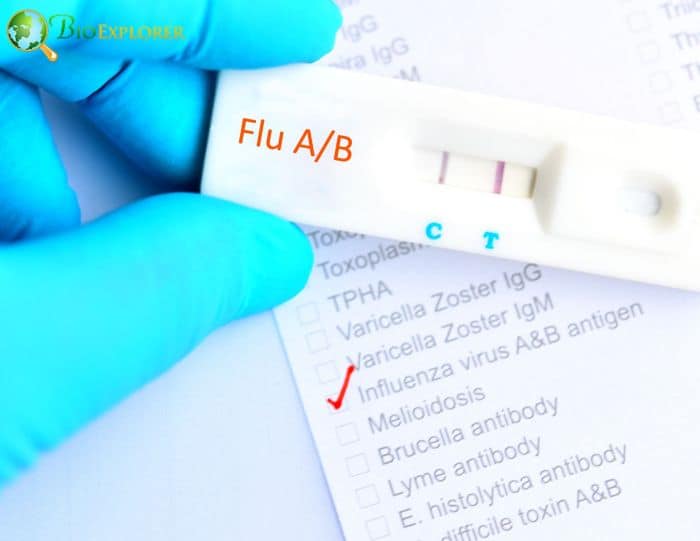
In patients with SARS-CoV-2 coinfection, the influenza A virus prevents SARS-CoV-2 reproduction in the lung, and this interference can last up to one week following influenza A clearance. According to a study, if the patient gets the influenza A virus first, the immune system‘s reaction to that infection can considerably reduce SARS-CoV-2.
- Early in the COVID-19 pandemic, co-infection with SARS-CoV-2 and the influenza A virus was frequent.
- According to the study, the influenza A virus interacts with SARS-CoV-2 reproduction in the lung for up to one week after influenza A is no longer present. These observations imply the presence of[influenza A virus] intrinsic or induced variables that may limit the proliferation of SARS-CoV-2. However, it is still unknown whether this effect contributes to disease severity.
- The trials were carried out by the researchers both in golden hamster animal models and in cultured cells. The two viruses were given to the animals simultaneously, and they were observed on days 1, 3, 5, and 7 after infection.
- In other trials, the scientists exposed the animals to one virus at the beginning, then the other three days later, while keeping track of them on days 1, 3, and 5 following the second challenge.
- The scientists used an animal model to show that coinfection does not worsen the course of the disease.
These findings imply that SARS-CoV-2 and influenza co-infection is no imminent danger to human life. This study can illustrate how an immune response to an unrelated stimulus can offer a defense against SARS-CoV-2.
Suggested Reading:
25 Reasons That Emphasizes The Importance of Biology
9. Scientists say that as the battle in western Ukraine progresses, the probability of a polio breakout increases (USA, June 2022)
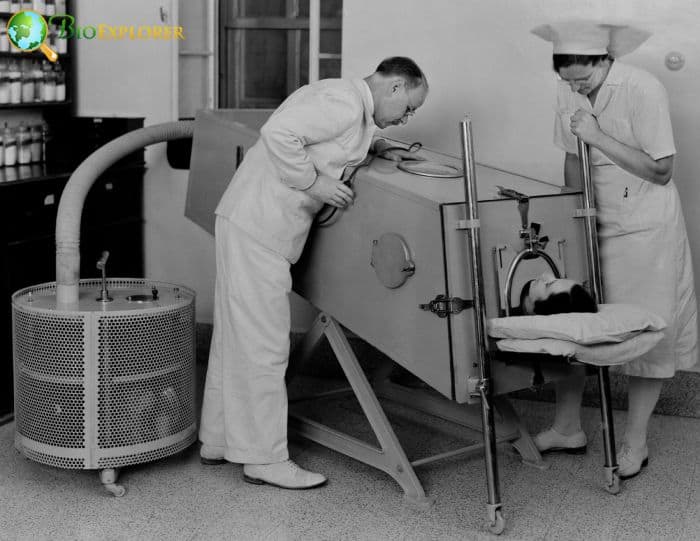
In Ukraine, which is regarded as a high-risk nation for vaccine-preventable illnesses, such as poliomyelitis, a very serious disease that paralyzes children, the return of the wild-type poliovirus or the circulating vaccine-derived poliovirus (cVDPV) poses a considerable threat. Scientists confirm that the COVID-19 outbreak, the ongoing conflict in Ukraine, and the healthcare reforms have all made the situation worse.
- A 1.5-year-old Western Ukrainian boy was diagnosed with paralytic poliomyelitis on October 6, 2021, and the shed poliovirus was genetically related to a sample from Dushanbe, Tajikistan.
- 19 paralytic polio cases have been confirmed in western Ukraine since January 2022, prompting the provinces of Rivne and Zakarpattia to declare a public health emergency.
- The Russian Federation invaded Ukraine on February 24, 2022, leaving behind occupied territory, millions of refugees, and thousands of internally displaced people.
- This caused severe disruptions in normal vaccinations, access to medical care, and responses to the polio outbreak in Ukraine.
- Due to poor immunization rates (73.3% as of December 2021) and regional immunization gaps, there is a considerable risk of dissemination. These elements increase the likelihood that the virus will travel abroad and infect nations without polio.
Along with foreign partners, the Ukrainian Ministry of Health has created a coordinated plan to combat the outbreak. These include enhancing national surveillance, immunization campaigns for children under 6 who have never been vaccinated, and lobbying and outreach initiatives.
Suggested Reading:
Explore Virus Structure, Viral Structure Types, and Functions
10. According to a recent study, probiotics along with prescription antibiotics may lessen harm to the gut microbiome (UK, Nov 2022)
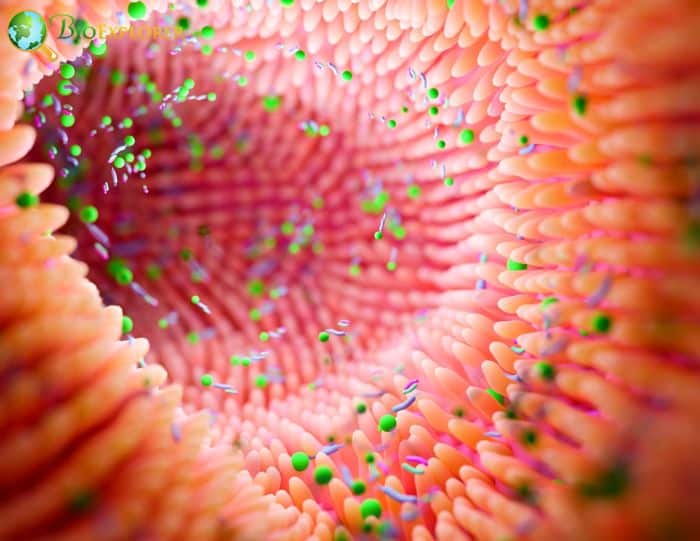
The beneficial bacteria in our stomachs are also killed by antibiotics, even though they can be highly successful in treating infections. There is proof that this alteration in the composition of the gut microbiome can persist for up to two years following antibiotic therapy. Antibiotics can also cause gastrointestinal adverse effects like bloating and diarrhea.
- According to a recent study, this is the first time a comprehensive evaluation has been done to determine how taking probiotics together with antibiotics affects the diversity and makeup of the human gut microbiome.
- The study assesses patterns from 29 studies released over the previous seven years. It has been discovered that consuming probiotics and antibiotics can stop or reduce some antibiotic-induced alterations to the gut microbiota composition.
- Moreover, probiotics can aid in preserving species variety and even the population recovery of some beneficial microorganisms, such as Faecalibacterium prausnitzii, which lowers inflammation and supports a healthy gut barrier.
- Antibiotic use causes many recurring alterations in some species of bacteria. Nevertheless, most of those alterations were less noticeable, and several modifications were completely avoided when probiotics were included in the therapy regimen.
There does not appear to be a cause to withhold a prescription for probiotics, while antibiotics are provided based on the human evidence that is currently available.
Suggested Reading:
Latest Discoveries In Microbiology 2019
11. A study reveals intricate connections between bacteria, lower airway infection, inflammation indicators, and cystic fibrosis (USA, Mar 2022)
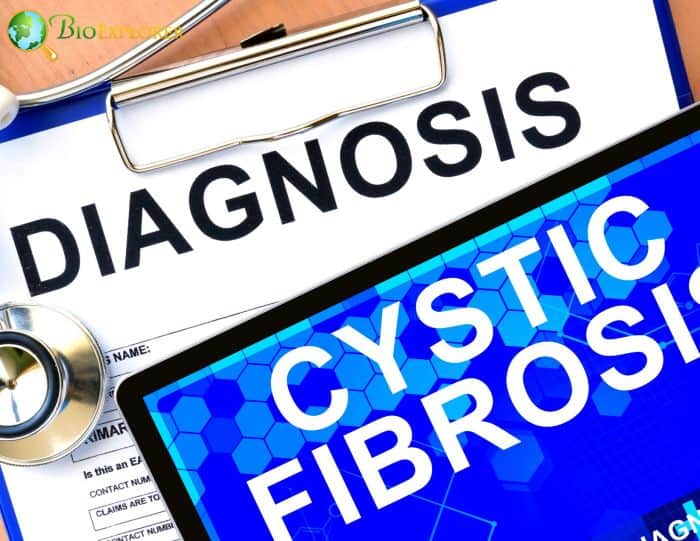
According to a study, the lower airways of people with cystic fibrosis (CF) show distinctive biochemical characteristics that correlate with the intricate communities of lung bacteria typical of this condition. The primary factor in sickness and mortality in patients with cystic fibrosis is chronic airway infection and inflammation, which results in progressive, obstructive lung disease.
- Samples from 90 bronchoalveolar lavage fluid (BALF) were obtained during bronchoscopy, and various metabolites were analyzed better to understand the molecular mechanisms of infection and inflammation.
- Children with and without CF were used to collect these lower airway samples. The bacterial populations present in these samples were also characterized by genetic sequencing, and the results were then compared to the metabolites in the lungs.
- The scientists found biomarkers for metabolites that may be connected to biochemical processes linked to increased inflammation and bacterial load in the CF lung.
- An increase in amino acids and a decrease in acylcarnitines were revealed to be two metabolomic traits specific to CF and may one day be used as biomarkers for infection and inflammation.
- Furthermore, L-methionine-S-oxide, a metabolite of relevance in the development of chronic CF lung illness, was negatively associated with the number of anaerobic bacteria and favorably adjusted with Staphylococcus, a typical CF infection.
The research is still in its early phases; therefore, the findings are not yet available for clinical use. However, it provides the foundation for further research to revolutionize medical care for children with CF.
Suggested Reading:
Explore 13 Different Shapes of Bacteria
12. Metabolic activity can be predicted by the genomic structure of microbial communities (USA, Jan 2022)

A recent ecologist study demonstrates that the genes in a microbial community can predict the community’s dynamic metabolic activity, with implications for the nitrogen cycle and other significant biogeochemical processes.
- Scientists may be able to infer metabolite dynamics from the community’s overall gene content, design microbial communities for particular functions, and learn how genome evolution affects metabolism due to the metabolic genes’ ability to predict its dynamic behavior.
- However, bacteria are abundant in the natural world and carry out various vital environmental tasks, such as photosynthesis, which fixes carbon and creates oxygen, or removing nitrogen from the atmosphere and converting it into a form other organisms can use.
- On the contrary, these bacteria occur in ecological communities where they interact with countless other microbes, compete for nutrients, and exchange them with one another.
- Nearly one hundred different bacteria were collected from soil samples taken from farms and forests near Urbana, Illinois, and they were then studied in the lab.
- They then sequenced their genomes to obtain a list of all the genes present, and they monitored metabolite changes as these organisms grew, concentrating on the denitrification process, a crucial stage in the nitrogen cycle.
- These data underwent statistical analysis, which revealed that the key denitrification genes and the rates at which they consumed and produced denitrification metabolites had comparatively straightforward relationships.
- They then created a mathematical model depicting the various organisms’ interactions.
So, this knowledge to create microbial communities with specific objectives in mind, such as for use in farming or wastewater treatment.
Suggested Reading:
Best Colleges For Environmental Engineering
13. A new tool for biotechnology and medicine is created by researchers in the form of a chip that can detect microbial dark matter in soil, water, and the air (Germany, Nov 2022)

From the seafloor to human intestines: Microorganisms can live there regardless of how hostile a habitat is. Their wide variety of coping mechanisms holds great promise for biotechnology. However, most of these organisms are unknown because they can’t be grown.
- A group of scientists has now created a silicone “sponge” that is porous and remolded to utilize better this “microbial dark matter“. The material absorbs nearby microorganisms while embedded in a chip, which can be used for additional research.
- Studies have shown that this silicone sponge’s holes can hold various microorganisms.
- The team discovered Actinobacteriota species in the dry air of a poultry farm. Antibiotics must be produced using these microorganisms. Additionally, they can be used to create substances that treat particular cancer diseases.
- Researchers believe that new bacteria that could aid in biomedicine can be discovered by using a sponge. This pesticide “attracted” glyphosate-processing microorganisms into the sponge.
- After contacting soil samples, the porous material quickly became colonized by microbes. The scientists had to alter how medical silicone was processed to make it livable for microorganisms.
- The team gave the polymer table salt, which was then dissolved again. Small passageways connecting the holes formed as a result. It was possible to get the desired sponge-like structure.
Researchers then created a “chip” for applications. The silicone in this tiny device is the same as in the sponge, but it is in a homogeneous form rather than a porous one.
Suggested Reading:
Top 10 Microbiology News of 2020
14. Scientists discovered that Type-1 diabetes has microbial roots (USA, Oct 2022)

BefA, a bacterial protein, breaks down cell membranes, causing crucial insulin-producing cells in the pancreas to proliferate early in development. The discovery suggests a potential strategy for increasing this cell population and preventing Type 1 diabetes.
- The production of insulin by a specific subset of beta cells in the pancreas is necessary for the body to control blood sugar levels.
- Additionally, the period of early childhood development is a brief one during which beta cells reproduce and multiply. The immune system attacks beta cells in people with Type 1 diabetes, reducing their population and the amount of insulin that can be produced.
- Immune system development stimulated by the microbiome helps properly orient the immune system and avoid autoimmunity.
- Work by Guillemin’s group points to another function for the microbiome: It promotes beta cell population growth early in development, acting as a protective buffer against autoimmune attack-induced beta cell depletion later.
- They demonstrated that BefA could damage the membranes of numerous bacterial and animal cell types.
- It makes sense that bacteria in the gut would attack rival bacteria. They also discovered that BefA’s attacks on the insulin-producing cells’ membranes caused those cells to proliferate.
The research team led by Guillemin envisions potential therapeutic uses for the discovery in the future. For instance, proactively boosting the microbiomes of infants at high risk with bacteria that produce BefA may shield them from later developing type 1 diabetes.
Suggested Reading:
Top 15 Latest Microbiology & Virology Discoveries in 2018
15. Researchers believe that triple therapy reduced the risk of death in patients with severe COVID-19 who were hospitalized (USA, Aug 2022)
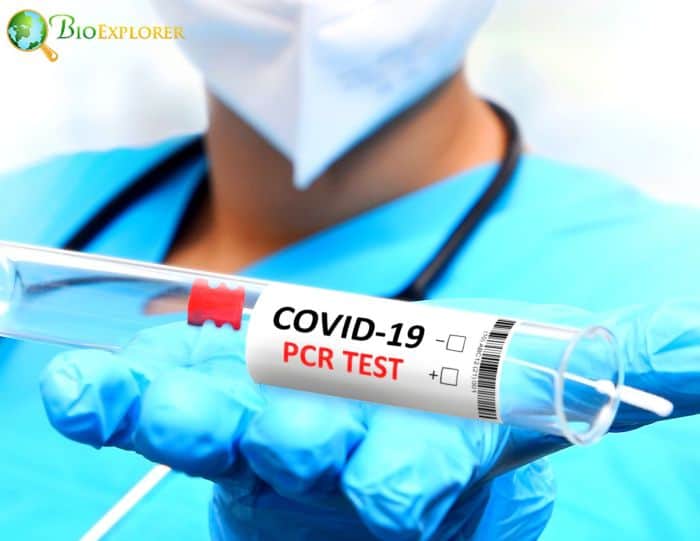
According to recent research, patients with severe COVID-19 who were hospitalized fared better when baricitinib was added to remdesivir and dexamethasone.
- The study compared the outcomes for 110 patients treated at Saint Peter’s between June 2020 and June 2021 with remdesivir and dexamethasone and 81 patients treated there with both those drugs plus baricitinib.
- Although triple therapy was linked to a lower risk of death, neither the use of ventilators nor the length of stay in the hospital was shortened.
- The ultimate implications show that patients hospitalized with severe COVID-19 who received triple therapy had a halved risk of dying.
Suggested Reading:
Top 11 Microbiology News In 2017
This series of microbiology news gives us a wider perspective on the recent advancement in this field. Commencing with the news that reports the killing of food poisoning bacteria using organic acid from a plant source, utilizing bacteria as renewable energy resource of methane gas into electricity, use of various new strains of bacteria due to plastic waste for more productive forms of synthesizing antibiotics, use of microbe as a rich source of biofertilizer, repurposing of antibiotics to combat against a broad spectrum of microbes. So, through this research and innovations, we anticipate more exciting findings in 2023.
![]()


